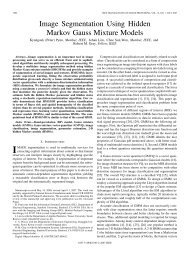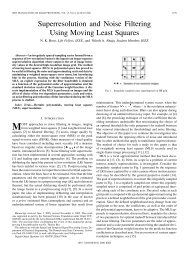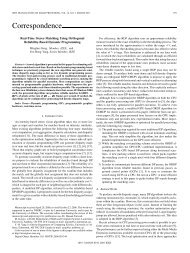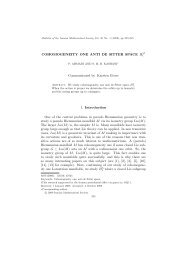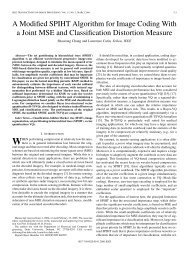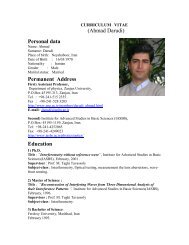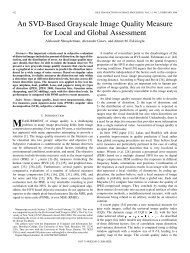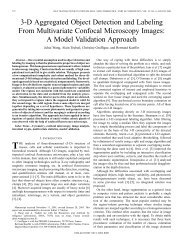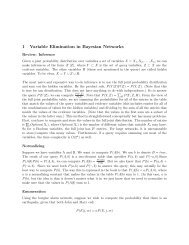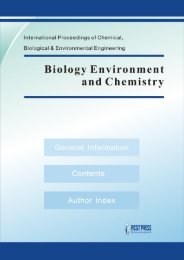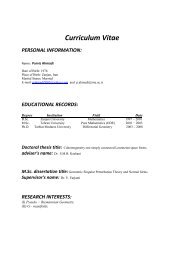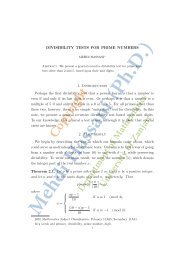Aromatic Substitution. XIII.la Comparison of Nitric Acid and Mixed ...
Aromatic Substitution. XIII.la Comparison of Nitric Acid and Mixed ...
Aromatic Substitution. XIII.la Comparison of Nitric Acid and Mixed ...
You also want an ePaper? Increase the reach of your titles
YUMPU automatically turns print PDFs into web optimized ePapers that Google loves.
3688 G. A. OLAH. S. J. KUHX, S. H. FLOOD AND J C ETANS Irol. s4<br />
ene sulfone) <strong>and</strong> with mixed acid nitrations in the<br />
same solvent systems.<br />
Nitration with <strong>Nitric</strong> <strong>Acid</strong> in Organic Solvents.---<br />
IYith nitric acid (used both as solvent <strong>and</strong> as<br />
nitrating agent) Ingold has found that nitrations<br />
are first order with respect to aromatic compounds.<br />
Allthough, according to Kaman spectroscopic ob-<br />
servations, :: anhydrous nitric acid contains ap-<br />
proximately lY0 <strong>of</strong> nitronium ion, solutions <strong>of</strong><br />
nitric acid in organic solvents such as nitromethane<br />
contain no detectable amount <strong>of</strong> nitronium ion.<br />
Ingold, Hughes <strong>and</strong> co-workers have found that<br />
sufficiently reactive aromatic compounds (benzene,<br />
toluene, ethylbenzene, etc.) exhibit, in nitrations in<br />
nitromethane solutions, zeroth order kinetics, ;.e.,<br />
the reaction rates are independent <strong>of</strong> the nature or<br />
concentration <strong>of</strong> the substrate indicating that the<br />
aromatic compound takes no part in the rate-de-<br />
termining step. This step must therefore be limited<br />
to the nitric acid (with the possible assistance <strong>of</strong> the<br />
solvent) <strong>and</strong> was found to be the formation <strong>of</strong> X02+.<br />
The necessary- condition in the formation step <strong>of</strong><br />
the nitronium ion is that the rate <strong>of</strong> the recombi-<br />
nation <strong>of</strong> nitronium ion with water should be much<br />
slower than the rate <strong>of</strong> reaction <strong>of</strong> the nitronium<br />
ion with the aromatic compound. In nitro-<br />
methane solution there will be at the start <strong>of</strong> the<br />
reaction a minute concentration <strong>of</strong> water arising<br />
from the ionic self-dehydration <strong>of</strong> the nitric acid.<br />
During the reaction this will be increased, but the<br />
water concentration will always be much less than<br />
that in the partly aqueous solution. In nitro-<br />
methane solution the zeroth order rate was ob-<br />
served by Ingold <strong>and</strong> Hughes in almost all cases<br />
involving compounds with reactivities equal to or<br />
greater than that <strong>of</strong> benzene. The addition <strong>of</strong><br />
small quantities <strong>of</strong> water to nitromethane has little<br />
effect on the zeroth order rate. This is expected,<br />
since water does not enter into the pre-equilibrium<br />
step <strong>and</strong> therefore does not reduce the concentra-<br />
tion <strong>of</strong> the nitracidium ion. IThen more water is<br />
added, a point is reached where the water competes<br />
with the aromatic compound for the limited supply<br />
<strong>of</strong> the nitronium ion. The kinetics then change to<br />
a first-order form. 16<br />
The re<strong>la</strong>tive reactivity <strong>of</strong> toluene <strong>and</strong> benzene in<br />
competitive nitration with nitric acid in nitro-<br />
methane was found by Ingold" to be 21, using<br />
a di<strong>la</strong>tometric technique. Employing gas-<br />
liquid chromatography as an analytical method,<br />
the nitric acid nitration <strong>of</strong> benzene. toluene, ethyl-<br />
benzene, $-xylene <strong>and</strong> mesitylene were cornpared<br />
in competitive experiments (Table I). The results<br />
are in excellent agreement with Ingold's data for<br />
the toluene : benzene reactivity ratio <strong>and</strong> also<br />
establish high substrate selectivity <strong>and</strong> the usual<br />
isomer distributions in the nitration <strong>of</strong> the other<br />
alkylbenzenes.<br />
<strong>Nitric</strong> acid nitration <strong>of</strong> toluene <strong>and</strong> benzene in<br />
acetic anhydride <strong>and</strong> acetic acid solutions was in-<br />
vestigated by Ingold <strong>and</strong> Hughes during their<br />
sTTstematic study <strong>of</strong> nitrations." Knowles.<br />
Korman <strong>and</strong> RaddaI6 redetermined re<strong>la</strong>tive rates<br />
(I.?) E. 13. Hughes, C K. Ingold <strong>and</strong> R R. Pearsun, .I CIi~?ii. .So(.,<br />
4957 (1958).<br />
(It!) J. R Knowlep. R 0 C. Sorman <strong>and</strong> C,. K. RadBa, J. Chriii<br />
Sac., 48%



